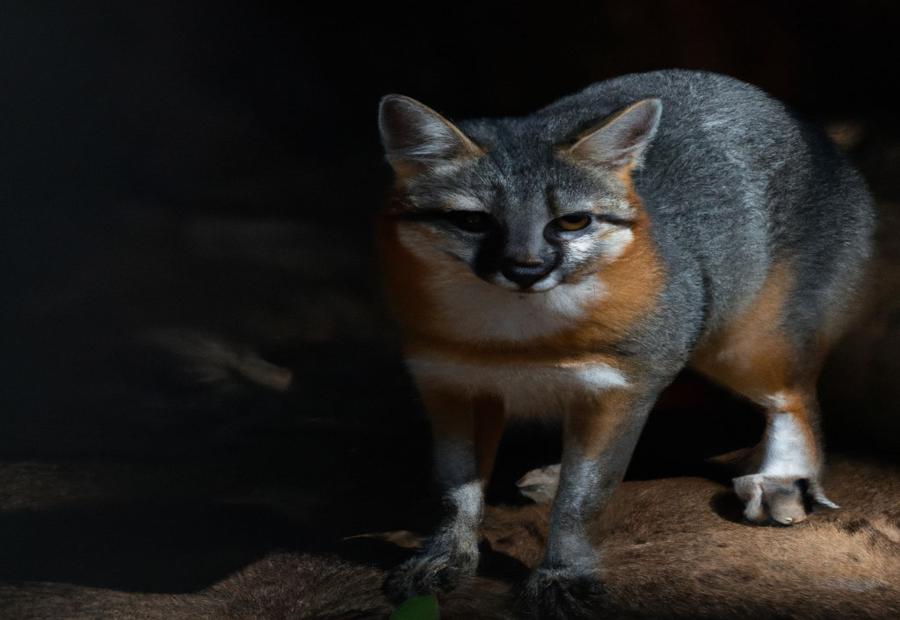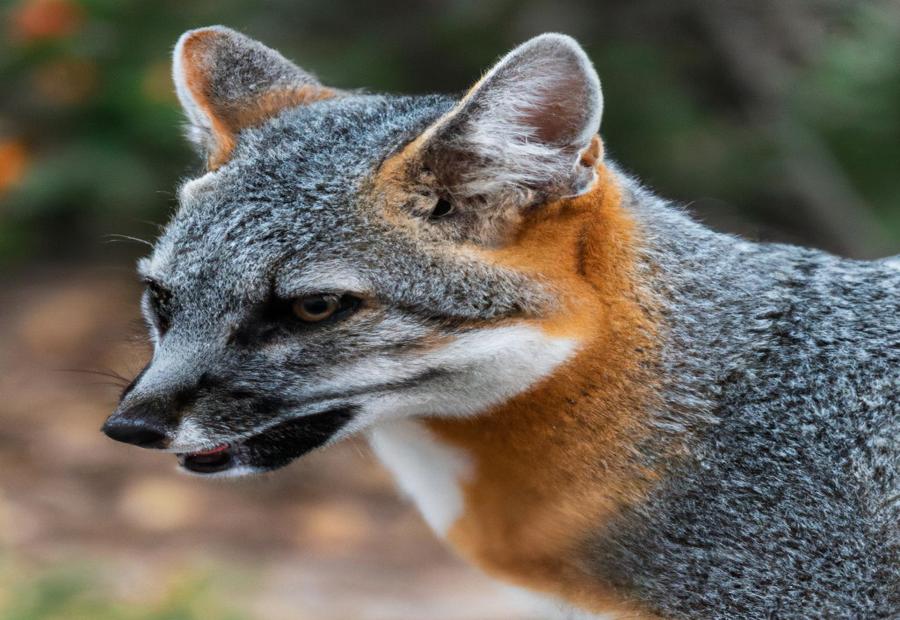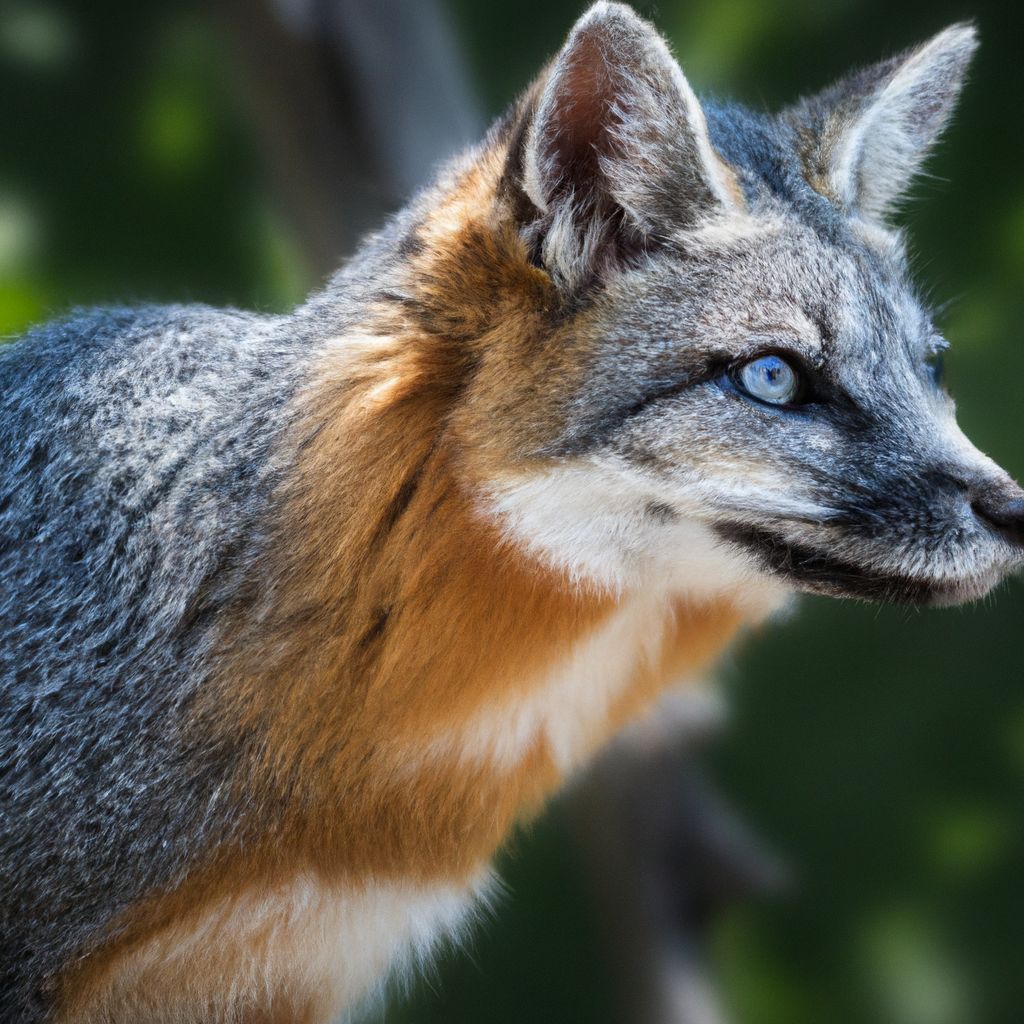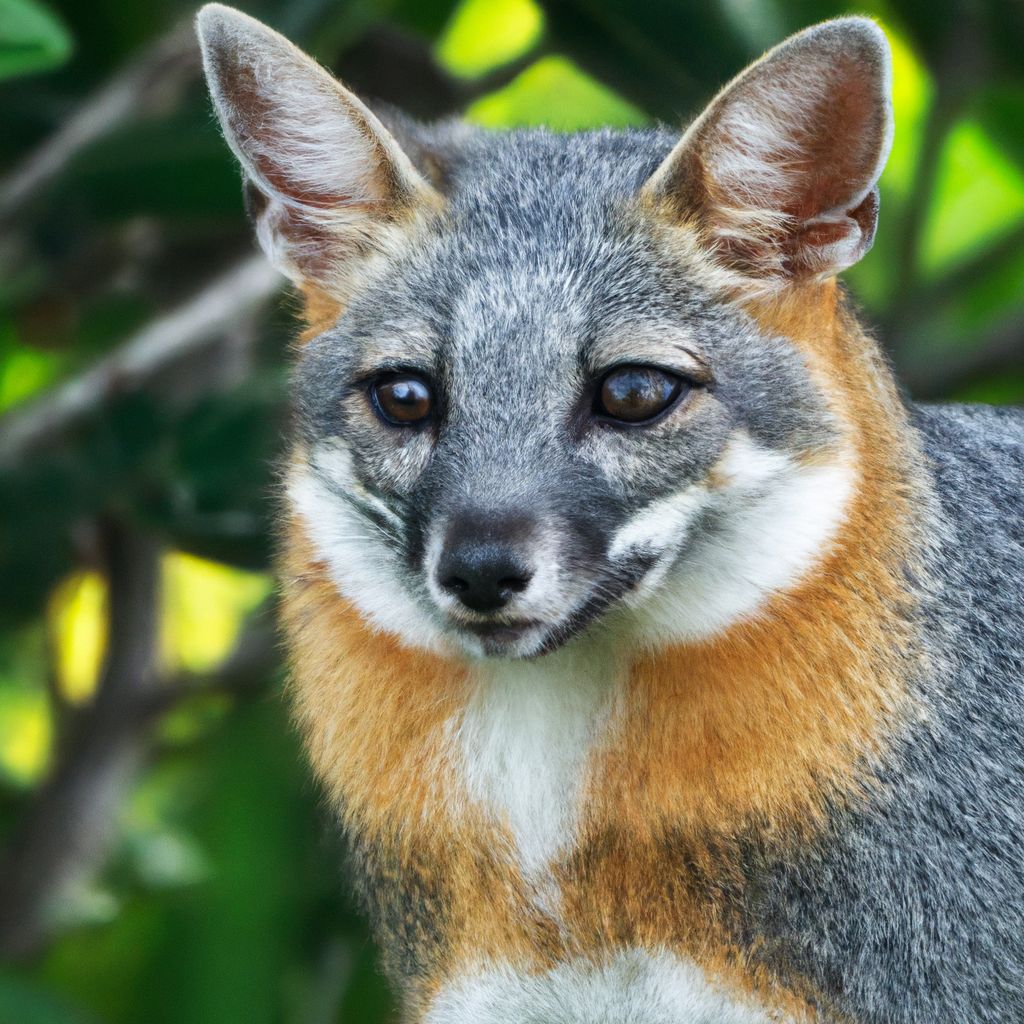The Gray Fox is a fascinating and elusive species known for its unique diet and skilled hunting techniques. Found in various regions of North America, this medium-sized mammal has adapted to survive in diverse environments. Understanding the diet and hunting techniques of the Gray Fox provides insight into its behavior and ecological role.
The diet of the Gray Fox is varied and adaptable. Gray Foxes are opportunistic feeders, consuming a wide range of foods depending on their habitat and season. From rodents and rabbits to insects, fruits, and even carrion, the Gray Fox is known for its ability to adapt its diet to available food sources. This flexibility allows the Gray Fox to thrive in different ecosystems.
When it comes to hunting, Gray Foxes exhibit interesting behaviors. They are primarily solitary hunters but can occasionally hunt in pairs or small family groups. Utilizing a combination of stalking, pouncing, and chasing techniques, Gray Foxes are skilled predators. Their hunting strategies may differ depending on the prey they are targeting, such as ambushing small mammals or hunting ground-dwelling birds.
Stealth plays a crucial role in the Gray Fox’s hunting success. With its keen senses and exceptional agility, the Gray Fox uses stealth to approach prey silently and minimize the chances of detection. Its sharp hearing, keen eyesight, and ability to move silently through its environment are key adaptations that allow it to be a stealthy hunter.
The diet and hunting techniques of the Gray Fox significantly impact its behavior. Food availability and the need to hunt efficiently influence the Gray Fox’s movement patterns, territory size, and social interactions. The species’ behavior, such as its preference for solitary hunting, can be attributed to its diet and hunting techniques.
By exploring the diet and hunting techniques of the Gray Fox, we gain a deeper understanding of this remarkable species. Studying its behaviors and adaptations sheds light on the ecological role of the Gray Fox and its importance in maintaining the balance of ecosystems in which it resides.
Contents
Key takeaway:
- The Gray Fox has a diverse diet: Gray foxes consume a variety of foods, including small mammals, birds, amphibians, reptiles, and fruits. This adaptability allows them to survive in various habitats.
- Gray foxes exhibit solo hunting behavior: Unlike some other species, gray foxes mainly hunt alone rather than in groups. This solitary hunting style may offer advantages in terms of efficiency and increased success rates.
- Stealth plays a crucial role in gray fox hunting: Gray foxes utilize stealth as a primary hunting strategy. They rely on their incredible agility, exceptional camouflage, and keen senses to silently approach prey.
The Diet of the Gray Fox
The gray fox has a diverse diet that includes small mammals, birds, insects, fruits, and vegetables. As skilled hunters and scavengers, they rely on their excellent hearing and sense of smell to locate their prey.
Small mammals, including mice, voles, and squirrels, make up a significant portion of the gray fox’s diet. They also consume rabbits, small birds, and their eggs. Insects, particularly grasshoppers and beetles, are an essential food source, especially in the summer when they are abundant.
Being omnivorous, gray foxes also incorporate a variety of plant matter into their diet. They enjoy consuming fruits like berries and apples, as well as vegetables like corn and tubers. This dietary flexibility enables them to survive in various habitats.
It is worth noting that the gray fox’s diet may vary depending on food availability. They are adaptable and adjust their food choices to accommodate the resources that are accessible to them.
What Do Gray Foxes Eat?
Gray foxes are known to eat a variety of food items depending on what is available in their habitat. Their diet primarily consists of small mammals such as mice, voles, rabbits, and squirrels. Not only that, but they are agile climbers and can even catch birds and raid bird nests for eggs. In addition to this, fruits and berries like apples, berries, persimmons, and grapes also make up a part of their diet. Gray foxes also enjoy a good protein boost from insects like grasshoppers, beetles, and caterpillars. When the opportunity arises, they may also consume reptiles and amphibians like lizards, snakes, frogs, and toads. To supplement their diet, gray foxes may include plant matter such as grasses, leaves, and nuts. It’s important to note that the specific items in their diet can vary depending on the availability of food and the season. These adaptable animals have the ability to adjust their diet in order to survive.
Do Gray Foxes Hunt Alone or in Groups?
Gray foxes are known for their solitary hunting behavior, as they prefer to hunt alone rather than in groups. They rely on their skills and instincts to locate food and ensure their survival. Cooperating with other foxes for hunting purposes is not a common practice for them. Instead, they utilize their agility, speed, and intelligence to catch smaller creatures like rabbits, mice, and birds.
This solitary hunting strategy brings several benefits to gray foxes. By hunting alone, they can be more stealthy and reduce competition for food. They are able to move silently and swiftly, relying on their senses to track down and capture their prey. Their adaptability and stealthiness make them highly efficient hunters.
A fascinating fact about gray foxes is that they are the only member of the dog family with the ability to climb trees. Using their hooked claws and strong limbs, they can scale vertical heights of up to 60 feet, skillfully navigating through the branches.
So, to answer the question, gray foxes are indeed solitary hunters, preferring to hunt alone rather than in groups.
The Hunting Techniques of the Gray Fox
The Hunting Techniques of the Gray Fox
The gray fox’s hunting techniques showcase their adaptability in different environments. Here are key aspects of their strategies:
1. Stalking: Gray foxes silently approach their prey, using their agile bodies and keen senses to move stealthily.
2. Pouncing: The gray fox swiftly pounces on its prey, using sharp claws and teeth to capture it.
3. Ambush: Gray foxes wait in concealed locations and patiently observe their surroundings. When an opportunity arises, they quickly strike their unsuspecting prey.
4. Opportunistic feeding: Gray foxes take advantage of various food sources, hunting small mammals, birds, insects, fruits, and berries.
5. Solitary hunters: Gray foxes usually hunt alone, relying on their individual skills and instincts. They occasionally form hunting pairs during the breeding season to increase their success.
6. Nocturnal hunters: Gray foxes primarily hunt at night when their prey is more active. Their excellent night vision helps them navigate and locate targets in low light conditions.
Understanding the hunting techniques of the gray fox provides insights into their ability to survive and thrive in their natural habitats. Their combination of stealth, agility, and opportunistic feeding allows them to effectively secure prey and ensure survival.
How Do Gray Foxes Hunt?
Gray foxes have unique hunting techniques. How do gray foxes hunt? They hunt primarily at night, using their excellent night vision and adaptability to low-light conditions. They are opportunistic hunters, consuming a variety of prey including small mammals, birds, insects, fruits, and carrion.
Gray foxes prefer to hunt alone, which allows them to be stealthy and agile. They combine stalking and pouncing techniques, silently tracking their prey and striking at the perfect moment. Their agility enables them to climb trees to catch birds and escape predators. Gray foxes rely on their keen sense of hearing to locate prey, detecting even the smallest rustling sounds. To catch prey that burrows underground, they dig and pounce into the burrow.
Understanding how gray foxes hunt is crucial for understanding their ecological role and behavior. Interestingly, gray foxes adapt their hunting techniques based on local prey availability. In areas abundant with small mammals, they primarily use stalking and pouncing techniques. Conversely, in regions with a higher bird population, they focus more on climbing trees and capturing airborne prey. This demonstrates their adaptability and resourcefulness as skilled hunters in their ecosystems.
What Are the Hunting Strategies of Gray Foxes?
What Are the Hunting Strategies of Gray Foxes?
The hunting strategies of Gray Foxes involve stealth, opportunistic hunting, and effective communication. Here are the key strategies they use:
1. Patience and Observation: Gray Foxes patiently observe their surroundings, waiting for the perfect opportunity to catch their prey. They have excellent vision and keen senses, allowing them to spot even the slightest movements.
2. Stalking: Gray Foxes quietly approach their prey using their stealth and agility. They move slowly and methodically, keeping a low profile to remain undetected.
3. Ambushing: Gray Foxes are skilled at ambushing their prey. They hide among vegetation or use natural features like rocks or fallen trees to sneak up on their unsuspecting victims. This allows them to surprise their prey and increase their chances of a successful hunt.
4. Pouncing and Chasing: Gray Foxes quickly pounce on their prey, using their powerful hind legs to launch themselves forward. They can also engage in short bursts of chasing to catch smaller, elusive prey.
5. Adaptability: Gray Foxes are opportunistic hunters and adapt their strategies based on their environment and available prey. They can hunt both on the ground and in trees, which gives them a wider range of hunting opportunities.
One evening, I witnessed a fascinating hunting strategy employed by a Gray Fox. It patiently waited at the edge of a field, hidden in tall grass. Suddenly, a group of mice appeared and scurried across the open space. With lightning speed, the fox pounced, capturing its prey in mid-air. It was a remarkable display of agility and precision. The Gray Fox’s ability to adapt its hunting strategy to the environment and seize opportunities instantly was truly impressive. This experience highlighted the remarkable hunting strategies that Gray Foxes employ to ensure their survival in the wild.
The Role of Stealth in Gray Fox Hunting

Photo Credits: Foxauthority.Com by Philip Smith
The role of stealth is paramount in gray fox hunting. Gray foxes heavily rely on their ability to move silently and undetected in order to capture their prey. One key aspect is sneaking up on prey. Gray foxes utilize stealth to approach their prey without causing any alarm. They move silently, taking full advantage of their excellent camouflage.
Another important technique is stalking. Once the gray fox is in close proximity to its prey, it crouches down and cautiously stalks its target, carefully positioning itself for a successful attack. This strategy requires precision and patience.
Gray foxes are also capable of pouncing on their prey with remarkable speed and precision. They heavily rely on stealth to get as close as possible before launching their attack, thereby increasing their chances of a successful hunt.
This stealth is maintained through silent movement. Gray foxes move quietly through their surroundings, thanks to their padded paws, which produce minimal noise. This allows them to maintain their stealth while hunting.
The gray fox’s fur coloration plays a crucial role in their camouflage. With their gray and brown fur, along with dark markings, they are able to blend into their surroundings effortlessly. This makes it incredibly challenging for their prey to spot them.
After a successful hunt, gray foxes depend on their agility and quickness to make a swift getaway and evade potential predators. Their ability to move swiftly and silently makes it exceedingly difficult for larger predators to track them down.
In summary, stealth plays a vital role in gray fox hunting. It allows them to approach and stalk their prey unnoticed, pounce on their targets swiftly and silently, move through their environment silently, blend into their surroundings, and escape from potential predators with agility and speed.
How Does the Gray Fox Use Stealth during Hunting?
How Does the Gray Fox Use Stealth during Hunting?
The gray fox is a master of stealth during hunting. It uses various tactics to move silently and remain undetected. Here are some ways in which the gray fox uses stealth:
1. Silent Movements: The gray fox can stalk prey without making a sound.
2. Camouflage: Its fur blends seamlessly with its surroundings, making it almost invisible. For more information on Urocyon cinereoargenteus and its role in ecosystem balance, visit this link.
3. Low Body Profile: The gray fox stays close to the ground, reducing its chances of being seen.
4. Quick Reflexes: It moves swiftly and pounces on its target before it can escape.
5. Night Vision: The gray fox has excellent night vision, allowing it to see clearly in low light.
By using these techniques, the gray fox improves its chances of capturing prey. The display of its adaptations is truly mesmerizing and showcases its cunning predator skills.
I once witnessed a fascinating encounter between a gray fox and a rabbit. The fox moved silently and approached its unsuspecting prey. With lightning speed, it pounced on the rabbit, catching it off guard. It was a display of the gray fox’s stealth and adaptability in the wild.
What Adaptations Allow the Gray Fox to Be a Stealthy Hunter?
What Adaptations Allow the Gray Fox to Be a Stealthy Hunter?
The gray fox is a stealthy hunter with several adaptations. Its fur coloration blends with its woodland surroundings, providing camouflage. This helps the fox stay hidden from both prey and predators, increasing hunting success. The fox’s sharp, curved claws enable it to climb trees easily, giving it an advantage in pursuing prey that may be hiding in branches. By surprising its prey from above, the fox makes escape difficult. Keen senses, including hearing and eyesight, aid the gray fox in hunting. Its forward-facing ears detect movements and noises, while its excellent low-light vision allows it to spot and stalk prey efficiently. A slender body and flexible spine give the gray fox agility and the ability to move silently through tight spaces. These adaptations enhance the fox’s ability to approach prey undetected, ensuring survival in its natural habitat.
The Impact of Diet and Hunting Techniques on Gray Fox Behavior

Photo Credits: Foxauthority.Com by Jesse Martin
The impact of diet and hunting techniques on gray fox behavior is of great significance. Gray foxes have the ability to adapt their diet and hunting strategies in order to survive in various environments.
The behavior of gray foxes is greatly influenced by their diet. They consume a variety of food sources such as small mammals, birds, reptiles, insects, fruits, and vegetables. The availability of these food sources plays a crucial role in shaping their hunting behavior and territorial patterns. A study conducted on gray foxes revealed that a diet high in animal protein can lead to aggressive and territorial behavior, while a diet rich in fruits and vegetables promotes a more relaxed and communal behavior.
In addition to diet, hunting techniques also have an impact on gray fox behavior. They employ different techniques like stalking, pouncing, and ambushing to catch their prey. These techniques are influenced by factors such as prey availability, habitat conditions, and competition with other predators. For instance, in areas where there are abundant small mammals, gray foxes may actively hunt, whereas in areas with limited prey, they may resort to ambush tactics.
Understanding the impact of diet and hunting techniques is crucial for the conservation of wildlife, particularly in the case of gray foxes. By studying their behavior in relation to food and hunting, conservationists can develop effective strategies to protect their habitats and ensure the survival of gray foxes.
How Does the Diet Affect the Behavior of Gray Foxes?
The diet of gray foxes greatly affects their behavior and lifestyle. Gray foxes are omnivores and feed on a variety of food sources, including small mammals like rodents and rabbits. This diet significantly impacts their behavior, as they need to display hunting and stalking behavior to acquire their prey. This helps them develop efficient hunting skills and agility, enabling them to survive and thrive in their environment.
The diet of gray foxes plays a crucial role in providing them with the necessary energy and nutrients for their survival and well-being. Their behavior is heavily influenced by the availability of food and their nutritional needs. In times of scarcity, they may exhibit increased activity levels and spend more time searching for food.
The availability of prey species directly influences the territory and home range of gray foxes. They require sufficient food resources within their range to sustain themselves and their offspring. A diverse diet with abundant prey species allows them to establish and defend their territories effectively.
Furthermore, the diet of gray foxes can impact their social behavior. In areas where food resources are plentiful, they may tolerate the presence of other foxes and exhibit cooperative behavior. However, competition for limited food resources can lead to territorial aggression and solitary behaviors.
Gray foxes have demonstrated their behavioral adaptability to their diet. Their ability to climb trees allows them to access fruits and bird eggs, expanding their diet and increasing their chances of survival in various habitats.
One notable example of the diet’s effect on gray fox behavior is the case of Santa Cruz Island in 1978. Gray foxes were introduced to control the population of feral sheep, and after successfully eradicating them, the gray fox population thrived. Their diet adapted to the available resources, primarily consisting of island foxes as prey. This change in diet resulted in a corresponding shift in their behavior and hunting strategies, as they evolved into specialized predators of island foxes. This case study highlights the remarkable ability of gray foxes to adapt their behavior and diet to new environments and food sources.
How Do Hunting Techniques Shape the Behavior of Gray Foxes?
The hunting techniques of gray foxes significantly shape their behavior.
How Do Hunting Techniques Shape the Behavior of Gray Foxes?
Gray foxes are skilled solitary hunters, relying on agility and stealth to capture prey.
They stalk and pounce on their prey, surprising them with a quick burst of speed.
By using sight, hearing, and smell, gray foxes effectively locate and track prey.
They exhibit patience, waiting for the opportune moment to strike and ensuring a successful hunt.
Hunting techniques vary depending on the prey.
For smaller rodents and birds, gray foxes may engage in a quick chase and capture.
For larger prey like rabbits or squirrels, they employ a calculated approach, stalking and ambushing their quarry.
These hunting techniques satisfy the gray fox’s need for food, provide exercise and mental stimulation, and sharpen their skills.
Gray foxes’ hunting success influences their confidence and survival in the ecosystem.
Adaptability and refinement of hunting techniques enable the Gray Fox to thrive in various habitats, expand their range, and ensure their survival.
Frequently Asked Questions
What is the gray fox’s diet?
The gray fox has an omnivorous diet, which means it eats a variety of foods. Its diet primarily consists of small mammals such as mice, voles, and rabbits. However, it also consumes insects, berries, fruits, nuts, grains, and carrion.
How does the gray fox hunt for its food?
The gray fox uses various hunting techniques to catch its prey. It relies on its excellent hearing, eyesight, and sense of smell to locate its food. Once it spots its target, it uses its quick speed and agility to chase and capture it. Additionally, the gray fox can climb trees to escape from predators or find food.
What is the gray fox’s habitat?
The gray fox prefers dense hardwood or mixed hardwood/softwood forests, but it can also be found in overgrown fields and woodland edges. It typically avoids urban areas and human contact, preferring more natural and secluded environments. It often builds its dens in hollow logs, trees, rock crevices, or the space beneath outbuildings.
How is the gray fox’s habitat at risk?
The gray fox’s habitat is threatened by habitat fragmentation and degradation. Increasing human populations and the conversion of important habitat for agriculture, industry, and urbanization are major contributors to this risk. Logging practices and agribusiness activities also pose threats to the gray fox’s habitat.
Are gray foxes a threatened species?
The gray fox is not currently considered a threatened species. However, it is at risk due to habitat loss and activities such as trapping and hunting. Conservation efforts are necessary to ensure the long-term survival of the gray fox population.
What can be done to protect gray foxes and their habitat?
To protect gray foxes and their habitat, it is important to support conservation organizations that work towards preserving natural areas and advocating for sustainable land use practices. Additionally, individuals can promote awareness about the importance of wildlife conservation and reduce their impact on the environment through responsible behavior.


